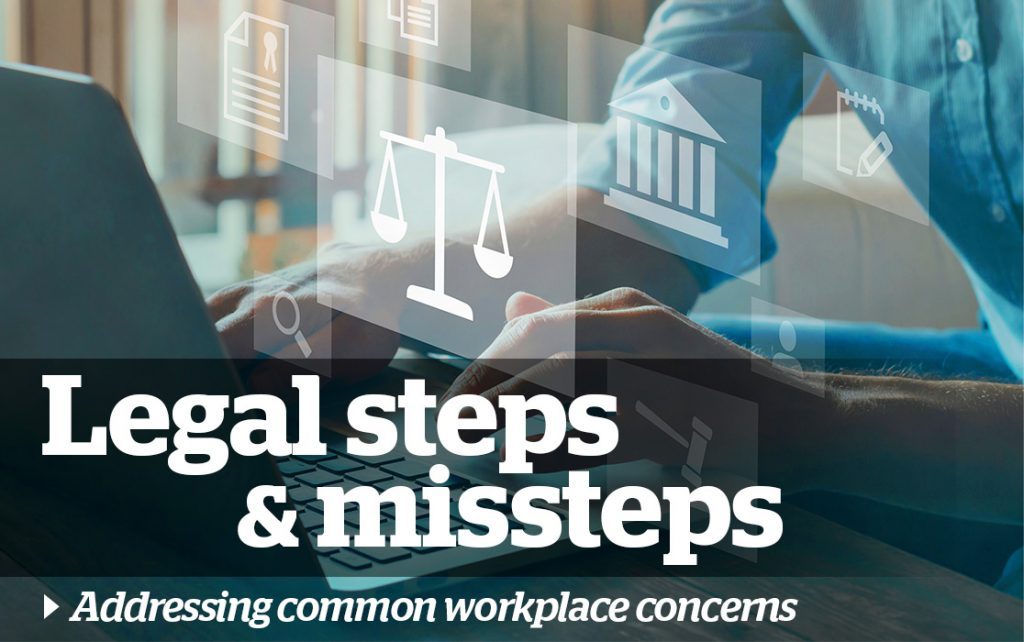
Will ‘densified offices’ still work post-pandemic?
February 16, 2021
By
John Hyde
Can de-densified workplaces become a legal term of employment?

EDITOR’S NOTE: ‘Legal steps & missteps: Addressing common workplace concerns’ is a weekly series published by Talent Canada, a sister publication to OHS Canada, in partnership with John Hyde of Hyde HR Law in Toronto. This series takes a deeper look at issues in which organizations can be proactive to prevent legal issues and highlight where common errors occur.
In the few years prior to the pandemic, a wave of employers were getting on board with the new trend of “office densification” — smaller workstations, “hotelling” desk space and “alternative” workspaces designed for more specialized tasks.
The timing of this trend was equally ironic and unfortunate for those employers who made the switch.
Now, pandemic health and safety measures are driving office design regulations and trends in almost the exact opposite direction.
Theory of office densification
As some employers and designers stated in recent years, the term “office densification” is somewhat misleading. Sure, each workstation shrinks in terms of square footage, but the lost space is made up for with the increase in usable square footage (USF) resulting from smaller computers, the removal of filing cabinets, etcetera.
Some of the lost square footage is also reallocated to so-called “alternative” spaces — shared use-specific workstations such as unique project rooms, comfy sofas, or sound-proofed “quiet rooms.”
The idea was to foster a collaborative environment, but to ensure that employees would be able to pick the appropriate setting depending on the task, as opposed to spending the entire eight-hour workday in one cubicle.
The concept picked up steam – in 2018, workplace design company, Ted Moudis Associates, found that more than half of all workplace seats (54 per cent) were “alternative seats.”
To make room for these changes, experts went to great pains to define the exact distance that “feels” too close to your co-worker.
In 2018, Jacobs Workplace Performance Strategies recommended a minimum five-foot-wide workstation, which provides about four feet of distance between co-workers.
They found that a distance of less than that made employees feel like their co-worker was “sitting in their lap,” but a distance of further than seven feet made discussions feel “more formal” and difficult to hear.
The culture, expectations and assumptions of a pre-pandemic world formed the fundamental basis for the design of contemporary “densified” offices. And it all happened at a great cost to the employer.
However, in March 2020, many of those offices were abandoned, both literally and figuratively.
Culture and expectations have changed fundamentally over the past year, while many of those offices remain unchanged — and in many cases — unoccupied.
Office densification vs. current guidelines
Office safety in the pandemic age pours water on the principles of office densification — and does so with remarkable specificity.
The Ontario Ministry of Labour takes a dim view of “alternative spaces,” suggesting that employers: “Limit the number of people sharing equipment or tools,” and to “assign tools, equipment and workstations to a single user if possible, or limit the number of users.” They recommend that employees wear masks, and that hard plastic barriers be installed where distancing is a challenge.
The distinction between what is considered a collaborative- vs. a dangerous-working distance is now very thin (if it exists at all). The Ministry of Labour currently recommends a distance between co-workers of two metres (about 6.6 feet).
These tensions are not easy to reconcile. The physical restrictions of a pandemic-safe workplace may be simply incompatible with the collaborative, modular workplace that many employers strived for pre-coronavirus.
Is ‘de-densification’ here to stay?
Long before the pandemic, office designers were aware of the potential hygienic risks associated with densification. In 2016, the Building Owners and Managers Association International wrote that the impacts in this respect were “unknown.”
While these concerns may have been a footnote in 2016, it will be very difficult for employers to brush these concerns aside in a post-pandemic world, whether COVID-19 continues to impact our daily lives or not.
Employers may also experience a cultural shift in terms of the things that matter most to employees.
Where in 2018 a ping-pong table, a comfy sofa, and a unique meeting space would have been appealing, employees may have become accustomed to perks that were brought on by necessity during the pandemic, such as personal space, flexibility, and work from home.
Employers will have to make tough calls, as there simply will not be enough room for both, especially in workspaces designed pre-pandemic.
Re-thinking office design
We would speculate that each employee’s bubble of personal space has significantly expanded over the past year.
Where in 2018, four feet would have felt like enough space for most employees, there is little doubt that expectations have since adjusted.
Reasonable expectations, in turn, become entrenched as legal terms of employment. Some employers may experience resistance to “re-densification” efforts in their office spaces, even when done within the parameters of the government guidelines.
If employers push too hard, this could lead to claims for constructive dismissal.
Re-thinking the design of workplaces in a post-pandemic world will be a tall order. Employers will need to consider health, culture, entrenched expectations, and of course, the law.
John Hyde advises management on all aspects of employment and labour law, including representation before administrative tribunals, collective agreement negotiation, arbitrations, wrongful dismissal defence and human rights.